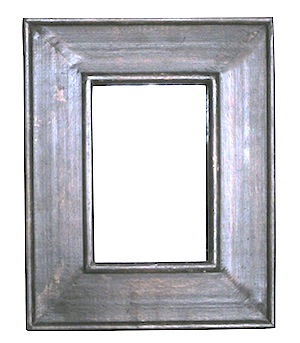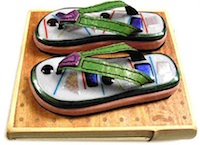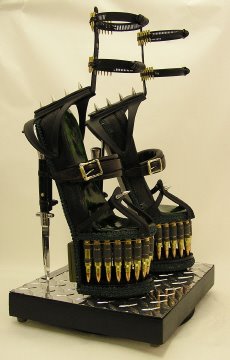Penny-wise
Last month I went to a show at a local art association gallery in a nearby town. It was a good juried exhibit. There were about 30 artworks on display from a variety of two dimensional media. The show was of local artists' work. I worked my way around the room slowly and deliberately with my people's choice ballot in hand, ready to mark down my favorite piece in the show. It was a difficult process, because while I felt that all the work in the show was good, nothing leapt out at me. As I worked my way around the room, I finally came to a blank spot on the wall. In the center of the blank spot and just above my eye level, there was an empty nail. To the right and just below my eye level was a label for a painting. It had the name of the artist, the name of the artwork, and the price. Beneath that label was another, indicating that the piece had taken second place in the show. Next to these labels was a red dot, indicating that the work had been sold. I suddenly wondered if my illusive people's choice vote had been sold out from under me.
The picture was gone. The viewing and voting public no longer had access to this prize winner. This was alarming to me. What kind of show was this that would allow work out while the show was in progress? How could the people's choice be meaningful? How could the show maintain its integrity with its viewers? I felt cheated and frustrated. The art association had gotten their commission, the artist had gotten his payment, the buyer had walked away happy, but it felt like an injustice had been done. The show, the jurors, and the viewing public had been betrayed. I felt as if the show had been raped for a buck.

Later, I asked about the missing painting. I asked several different members of the local association what was going on that they would allow a juried show in progress to be compromised by stripping out artwork immediately when it sold. I had only ever seen it done this way once before, and that time the show organizers had taken a merciless thrashing for doing it. But now, in this group, everyone I asked had the same answer, almost verbatim. "If we make a buyer wait until the end of the show to take their purchase home, they'll tell us to forget it. We have to let them take it immediately or we'll lose the sale."
"But don't you think it detracts from the show to have a gaping hole with a sold sticker where a painting once hung?" I asked. "No! It's wonderful! It tells people that art is selling, and it generates enthusiasm from the public. And we owe it to the artists to do everything possible to sell their work."
This situation sets up the biggest dilemma that artists wrestle with: the sometimes conflicting priorities of sales and exposure. Both are important, and arguments can be made either way.
One of the benefits of writing here is that I get the last word. And quite frankly, this policy is appalling to me. A juried show is not an art mart. It is not the usual commercial gallery display, in which work from the gallery's stable of artists is featured until it sells and replaced immediately by something else from inventory. A juried show is a specific entity in its entirety, and requires all of its components to function. The inclusion of a people's choice award in a show further reinforces the need for the show to remain intact for the duration of its run. The voting, and the award itself are rendered meaningless if the artwork begins to disappear on the opening night of the show.
Since that recent show I have begun working on the second Phantom Project exhibit, The View from Here. I have had several artists ask that work that sells be released to the buyer immediately, for fear of losing the buyer. Their argument was that since Paso Robles is a wine tourism town, lots of buyers will be from out of town, and will be unwilling to forego the immediate satisfaction of taking their purchase home on the spot.
I have spent far more energy on this topic in the past month than I imagined possible. I had no idea before last month just what a divining line exists on this issue. For some, the sale is sacred. For others, the continuity of the show is paramount. And you have certainly gotten the gist of my opinion on the matter from the preceding paragraphs. But what I really want to talk about is the practical problem, from the artist's perspective, in this policy. I maintain that it's penny-wise and pound-foolish to let the threat of a lost sale compromise the exposure of your art. Personally I would not submit my art to a show with this policy in place. I would feel this way even without the esthetic and ethical concerns I have over the idea of dismembering a show in progress. Those are reasons enough, but one of the most important things about showing art is exposure. You all know from past issues of Outside the Lines how I feel about the value of exposure. Selling is good, and ultimately important, but sales that prematurely take your work out of the public eye can actually be a deterrent to future sales. Simply put, it blocks the public from seeing your work. It can be fatal to the process of building and nurturing a broad following for you and your work.
There are serious art collectors who can enhance your visibility with a purchase. They are known buyers and other buyers take cues from what they are buying. But these people are rare, and understand the etiquet of the show. They are serious collectors and are not threatened by the abscence of instant gratification. They are savvy players in the game. But the guy who wants it now, and can't wait without losing interest is more an impulse buyer, and while his money is good, his purchase will probably land your work in the backwater of his private livingroom, never to be seen widely again.
I could go on about this, but it would be better to give you a real life example of what I mean. And if you have been reading Outside the Lines for a while, you might already know the example I will invoke. I take you back now to a conversation that we had with Larry LeBrane in our February 5 issue.
Larry:  I’ll give you a story. I did a pair of shoes, glass flip flops when I was doing flip flops. I finished them on a Friday and I was showing them on a Sunday at Dinosaur Caves. The show goes from 10:00 to 4:00 and this woman walks up and says, “I love those shoes, I want to buy them.” This was at 10:15. I had just opened. I said, "ok, I’ll sell them to you but I can’t give them to you until 4:00. I just finished them and nobody’s seen them. I want people to see them. So the money wasn’t really . . . I said I want more exposure, exposure’s more important than the money at that point. She said ok, she gave me a check and said I’ll be back at 4:00. So meanwhile, halfway through the day, another guy comes along and he says “I want those shoes.” I said I sold them but I can make another pair, but they won’t be just like that pair. I said, "they’ll be crazy like that. You tell me what colors you want, and I’ll make another pair." So he said ok. Meanwhile I’d been talking to Ronda about it and Ronda pipes up, “He’s thinking of making high heels next!” He said, “oh, tell me about it.” He asked what I was going to use for the base. I said I had this diamond plate aluminum that looks pretty cool. He said, "Oh great, I’m lining my garage in that stuff!" He has a house in Shell Beach. He’s in the oil industry in Bakersfield. He's got a house in Tahoe, he’s got a plane, he calls the pilot to fly him to SLO, so he can smoke his cigar and drink wine. I never would have had this conversation if I had let the woman take her flip flops at 10:15.
I’ll give you a story. I did a pair of shoes, glass flip flops when I was doing flip flops. I finished them on a Friday and I was showing them on a Sunday at Dinosaur Caves. The show goes from 10:00 to 4:00 and this woman walks up and says, “I love those shoes, I want to buy them.” This was at 10:15. I had just opened. I said, "ok, I’ll sell them to you but I can’t give them to you until 4:00. I just finished them and nobody’s seen them. I want people to see them. So the money wasn’t really . . . I said I want more exposure, exposure’s more important than the money at that point. She said ok, she gave me a check and said I’ll be back at 4:00. So meanwhile, halfway through the day, another guy comes along and he says “I want those shoes.” I said I sold them but I can make another pair, but they won’t be just like that pair. I said, "they’ll be crazy like that. You tell me what colors you want, and I’ll make another pair." So he said ok. Meanwhile I’d been talking to Ronda about it and Ronda pipes up, “He’s thinking of making high heels next!” He said, “oh, tell me about it.” He asked what I was going to use for the base. I said I had this diamond plate aluminum that looks pretty cool. He said, "Oh great, I’m lining my garage in that stuff!" He has a house in Shell Beach. He’s in the oil industry in Bakersfield. He's got a house in Tahoe, he’s got a plane, he calls the pilot to fly him to SLO, so he can smoke his cigar and drink wine. I never would have had this conversation if I had let the woman take her flip flops at 10:15.
Anyway, I finished the shoes for him and started working on the high heels, so we go to his house to show him the high heels I'm working on. His house is right on Ocean Avenue on the cliff of Shell Beach. The cliff is right across the street. So we go in the house and there’s the pair of shoes, sitting on the floor like a doorstop. But it’s white tile, white carpet leading to the living room and the shoes are there and it tells you “take off your shoes” without saying a word. It’s a hint. That’s where the shoes go, take them off. That was so cool. At first I thought, why’s it sitting on the floor but then I got it.

Peggy: He just walked by at the right time at Dinosaur Caves.
Michael: So if you had sold her the shoes—let her take them home in the morning—none of that would have happened.
Larry: Yes. I finished the stilettos and I said, I want people to see them, no one else has seen them so I want to borrow these for awhile and enter them in shows and stuff because that was more important.
Michael: So you just never know when it’s going to lead to something.
Larry: Exactly. You know the exposure is worth more than a quick sale. So just like with these shoes, I had the stilettos for a year, showed them around, and at the end of the year he bought them. Which was fine. if he hadn't, it would have been fine. I had the exposure, I became the shoe guy.
Larry's experience, and his philosophy about art marketing is far more sophisticated, and far more successful than any quick sale strategy you might entertain for getting your work hidden away in somebody's living room where only a handful of dinner guests will ever see it. Yes, you want lots of your work to end up in such isolated closeted environments, but only within the framework of a larger exposure to the art watching world. To sell a piece out from under a juried show only undermines that bigger picture.
|


 I’ll give you a story. I did a pair of shoes, glass flip flops when I was doing flip flops. I finished them on a Friday and I was showing them on a Sunday at Dinosaur Caves. The show goes from 10:00 to 4:00 and this woman walks up and says, “I love those shoes, I want to buy them.” This was at 10:15. I had just opened. I said, "ok, I’ll sell them to you but I can’t give them to you until 4:00. I just finished them and nobody’s seen them. I want people to see them. So the money wasn’t really . . . I said I want more exposure, exposure’s more important than the money at that point. She said ok, she gave me a check and said I’ll be back at 4:00. So meanwhile, halfway through the day, another guy comes along and he says “I want those shoes.” I said I sold them but I can make another pair, but they won’t be just like that pair. I said, "they’ll be crazy like that. You tell me what colors you want, and I’ll make another pair." So he said ok. Meanwhile I’d been talking to Ronda about it and Ronda pipes up, “He’s thinking of making high heels next!” He said, “oh, tell me about it.” He asked what I was going to use for the base. I said I had this diamond plate aluminum that looks pretty cool. He said, "Oh great, I’m lining my garage in that stuff!" He has a house in Shell Beach. He’s in the oil industry in Bakersfield. He's got a house in Tahoe, he’s got a plane, he calls the pilot to fly him to SLO, so he can smoke his cigar and drink wine. I never would have had this conversation if I had let the woman take her flip flops at 10:15.
I’ll give you a story. I did a pair of shoes, glass flip flops when I was doing flip flops. I finished them on a Friday and I was showing them on a Sunday at Dinosaur Caves. The show goes from 10:00 to 4:00 and this woman walks up and says, “I love those shoes, I want to buy them.” This was at 10:15. I had just opened. I said, "ok, I’ll sell them to you but I can’t give them to you until 4:00. I just finished them and nobody’s seen them. I want people to see them. So the money wasn’t really . . . I said I want more exposure, exposure’s more important than the money at that point. She said ok, she gave me a check and said I’ll be back at 4:00. So meanwhile, halfway through the day, another guy comes along and he says “I want those shoes.” I said I sold them but I can make another pair, but they won’t be just like that pair. I said, "they’ll be crazy like that. You tell me what colors you want, and I’ll make another pair." So he said ok. Meanwhile I’d been talking to Ronda about it and Ronda pipes up, “He’s thinking of making high heels next!” He said, “oh, tell me about it.” He asked what I was going to use for the base. I said I had this diamond plate aluminum that looks pretty cool. He said, "Oh great, I’m lining my garage in that stuff!" He has a house in Shell Beach. He’s in the oil industry in Bakersfield. He's got a house in Tahoe, he’s got a plane, he calls the pilot to fly him to SLO, so he can smoke his cigar and drink wine. I never would have had this conversation if I had let the woman take her flip flops at 10:15.


